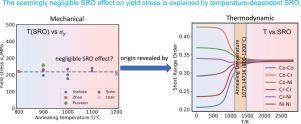近程阶的严格计算统一了其在复杂浓缩合金中的争议效应
IF 8.3
1区 材料科学
Q1 MATERIALS SCIENCE, MULTIDISCIPLINARY
引用次数: 0
摘要
复杂浓缩合金(CCAs)中化学短程有序(SRO)的直接实验观察引起了人们的高度关注。然而,关于SRO对屈服应力影响的报道是有争议的,其原子尺度机制是难以捉摸的,这限制了我们在合金设计中利用SRO的能力。在这里,我们使用一种先进的计算方法来解决这一挑战,该方法严格考虑了cca中的临界晶格畸变,并通过实验进一步验证了我们的理论预测。结果表明,CoCrNi模型合金在670℃左右形成SRO的温度窗较窄。这就解释了为什么在一些实验中观察到SRO的力学效应,而在另一些实验中却没有。我们提出了一种有效的合金掺杂方法来控制SRO,并揭示了不同合金中主导SRO形成的原子键类型。这些策略和见解通常适用于广泛的合金,为通过操纵其SRO来设计先进合金奠定了基础。本文章由计算机程序翻译,如有差异,请以英文原文为准。


Rigorous computation of short-range order unifies its controversial effects in complex concentrated alloys
Direct experimental observations of chemical short-range order (SRO) in complex concentrated alloys (CCAs) have triggered high interest. However, the reported effects of SRO on yield stresses are controversial, and their atomic-scale mechanisms are elusive, which limits our ability to utilize SRO in alloy design. Here we tackle this challenge using an advanced computational approach that rigorously takes into account the critical lattice distortion in CCAs and further verify our theoretical predictions with experiments. We show that the CoCrNi model alloy has a narrow temperature window around 670 °C for SRO formation. This explains why the mechanical effect of SRO is observed in some experiments but not in others. We propose an effective alloy-doping method to control SRO and reveal atomic-bonding types that dominate SRO formation for different alloys. The strategies and insights generally apply to a broad spectrum of alloys, laying the foundation for designing advanced alloys by manipulating their SRO.
求助全文
通过发布文献求助,成功后即可免费获取论文全文。
去求助
来源期刊

Acta Materialia
工程技术-材料科学:综合
CiteScore
16.10
自引率
8.50%
发文量
801
审稿时长
53 days
期刊介绍:
Acta Materialia serves as a platform for publishing full-length, original papers and commissioned overviews that contribute to a profound understanding of the correlation between the processing, structure, and properties of inorganic materials. The journal seeks papers with high impact potential or those that significantly propel the field forward. The scope includes the atomic and molecular arrangements, chemical and electronic structures, and microstructure of materials, focusing on their mechanical or functional behavior across all length scales, including nanostructures.
 求助内容:
求助内容: 应助结果提醒方式:
应助结果提醒方式:


